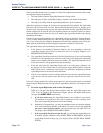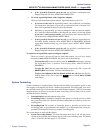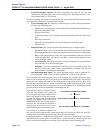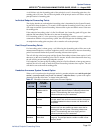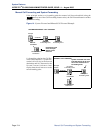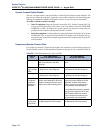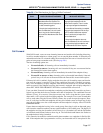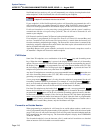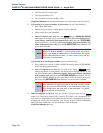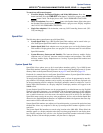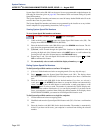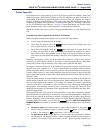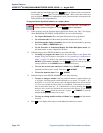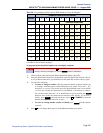
System Features
INTER-TEL
®
CS-5200/5400 ADMINISTRATOR GUIDE, ISSUE 1.1 – August 2005
Page 218 FWD Button
Not-Disturb and you receive a call, you will momentarily see a display showing that the desti-
nation endpoint is in Do-Not-Disturb; the call will remain at your endpoint.
If your endpoint is in Do-Not-Disturb and you have call forwarding programmed, the call is
still forwarded, unless you enabled Forward No Answer. With Forward No Answer, intercom
callers will see the programmed Do-Not-Disturb display, and the call will not be forwarded.
If calls are forwarded to a voice processing system application, and the system is unable to
communicate with the voice processing system PC, the call will not be forwarded. It will
remain at your endpoint.
Call Forward overrides System Call Forward at the principal endpoint.
If an endpoint is programmed for Forward No Answer or Forward No Answer/Busy and
receives a transferred call, the Forward No Answer timer is started when the intercom call
from the transferring endpoint begins ringing. The Forward No Answer timer is restarted if the
transferring endpoint completes the transfer before the timer expires (the transferred call will
then be forwarded when the timer expires).
Agent Help Request calls, queue callbacks, and recalls do not forward, except that a recall at
an Attendant’s endpoint will forward to another endpoint.
FWD Button
Some Inter-Tel endpoints use a combination of the default key and forwarding menu
keys. When the default key is pressed, the display shows a menu of call forwarding
options. The user must then select the desired option by pressing the corresponding key next to
the display. If the key is programmed to use any other Forward feature code (355–358)
the forwarding options will not be displayed when the key is pressed; the Inter-Tel
endpoint will operate the same as any other Inter-Tel endpoint.
Any Inter-Tel endpoint user can make any user-programmable button a button that uses
one of the forwarding feature codes (355–358). Refer to the procedures on page 168 for pro-
gramming user-programmable buttons.
A user-programmed button is lit only when the endpoint is programmed for the call
forwarding condition enabled by that button. For example, if a user-programmed but-
ton is set to forward calls when the endpoint is busy, the button will be lit when the Forward If
Busy feature is enabled, but not if the Forward If No Answer feature is enabled.
If an Inter-Tel endpoint user has both a fixed button and a user-programmable
button, the fixed button will always light when the endpoint is forwarded. However, the user-
programmable button will be lit only when the forwarding option activated by that but-
ton has been selected. For example, if the user has the Forward All Calls feature programmed
under a user-programmable button, that button will light if either the fixed or programmable
button is used to select that feature. However, if the fixed button or a feature code is
used to set the Forward If Busy feature, only the fixed button will light.
Forward to an Outside Number
When programming an endpoint for call forward to an outside phone number, a trunk access
code is programmed before the phone number. If the endpoint is called while the selected trunk
group is busy, the call will not be forwarded. Calls will ring at the forwarded endpoint until the
call is answered or the caller hangs up. The forwarded endpoint’s display shows FORWARD
TO BUSY TRUNK.
The forwarded endpoint’s (not the intercom caller’s) trunk and toll restrictions are checked
when an intercom call is forwarded to an outside number.
NOTE
Direct ring-in calls that are forwarded to an endpoint in DND will ring the DND
endpoint in accordance with the rules of DND.
FWD
FWD
FWD
FWD
FWD
FWD
FWD
FWD FWD
FWD
FWD



